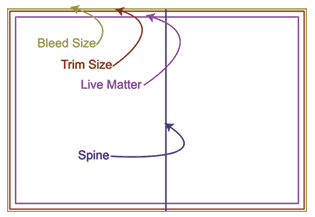The last step before a page goes to the printer
By John Potter
I don’t think most people realize how complicated things get once a page design has been approved and it’s time for the artist or designer to submit it to the printer.
Every printer has mechanical specifications that must be met in order for them to get your design onto the printed page. If you’re printing your own publication of course you can have a lot of control over this, but in magazine ads for instance you have to adhere to their standards.
There may be other things to take into account, but I’ll list some typical major ones. I based this upon requirements of an international magazine I prepare work for frequently.
 Bleed size: Bleed is when you want the image to off of the edge of the paper. Presses cannot print like that. They have to print a larger image than you need on an even larger piece of paper and then trim it down to size. Since printing presses are big mechanical beasts they need a little play also, so you have to make your image larger than you really want. It must go out to the printer’s specified bleed size.
Bleed size: Bleed is when you want the image to off of the edge of the paper. Presses cannot print like that. They have to print a larger image than you need on an even larger piece of paper and then trim it down to size. Since printing presses are big mechanical beasts they need a little play also, so you have to make your image larger than you really want. It must go out to the printer’s specified bleed size.
Trim Size: This is the size of the actual finished page.
Live Matter Area: All of your actual content must fit within this area. This is partially to accommodate the binding process that can pull some of the page into the middle or gutter of the magazine or book.
These are imaginary boxes only but the rules of their use must be adhered too. Proper markings including crop marks which indicate the trim size on pages with bleeds must also appear in the final art supplied to the printer.
If all of this sounds a little tedious and complicated it’s because it is, but it’s also very necessary to insure the final product is correct. If the mechanical preparation of you pages is done incorrectly you will probably be contacted by the publisher’s production manager. The stages that come after this which the production department at the printers deals with are even more tedious and complicated and (especially if it’s a magazine) they just don’t have time to be correcting other people’s mechanicals. Print production is one of the highest stress jobs I’ve ever witnessed first hand, so cut those guys a break and get it done right the first time.
Some things that have always made me scratch my head about the specs that are provided are…
- No one seems to supply templates in different software formats already laid out for this.
- Even though almost everyone does their mechanicals on computers they still supply measurements in fractions.
- There is always something that is required a fraction of an inch larger on all sides or smaller on all sides rather than just telling you the width and height of it.
My point is if you’ve never done this before and you’ve never been trained to do it the chances of you getting it right are infinitesimal. Hire a professional and get it done right the first time.
